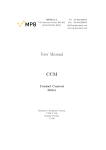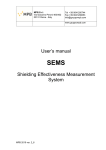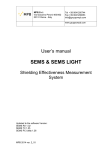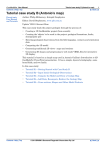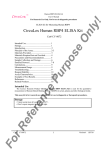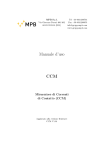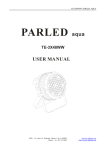Download User Manual
Transcript
MPB S.r.l. Tel +39 0641200744 Via Giacomo Peroni 400/402 Fax +39 0641200653 00131 ROMA (RM) [email protected] www.gruppompb.com User Manual CCM Contact Current Meter Updated to Firmware Version: CCM V1.03 SAFETY NOTES Read carefully before using the product MPB works to provide to its customers the best safety conditions available complying with the current safety standards. The instrumentation described in this manual has been produced, tested and left the factory in conditions that fully comply the European standards. To maintain it in safe conditions and ensure the correct use, these general instructions must be fully understood and applied before using the product. This product is designed for industrial environment and laboratories and should be used by skilled sta only. MPB disclaims responsibility for a dierent use of the device. Use the device only after checking the presence and validity of the safety devices (as breakers, dierential switches and the validity of grounding) For safety reason, the the HAND measure modality has to be done only after GROUND PLANE modality which marks a value below regulations limits dened by the 2013/35/EU regulation. II - User Manual CCM Declaration of Conformity (in accordance with the Directives: EMC 89/336/EEC and Low Voltage 73/23/EEC) This is to certify that the product: CCM (Contact Current Meter) complies with the following European Standards: Safety: CEI EN 61010-1 (2001) EMC: EN 61326-1 (2007) This product complies with the requirements of the Low Voltage Directive 2006/95/CE, and with the EMC Directive 2004/108/CE. MPB S.r.l. User Manual CCM - III IV - User Manual CCM Contents 1 2 3 4 General Information 1 1.1 Introduction . . . . . . . . . . . . . . . . . . . . . . . . . . . . . . 2 1.2 Descrizione . . . . . . . . . . . . . . . . . . . . . . . . . . . . . . 2 1.3 Composition . . . . . . . . . . . . . . . . . . . . . . . . . . . . . . 2 1.4 Optional Kit . . . . . . . . . . . . . . . . . . . . . . . . . . . . . . 2 1.5 Front . . . . . . . . . . . . . . . . . . . . . . . . . . . . . . . . . . 3 1.6 Rear . . . . . . . . . . . . . . . . . . . . . . . . . . . . . . . . . . 4 1.7 Technical Specications . . . . . . . . . . . . . . . . . . . . . . . . 5 Principle of operation 7 2.1 Logic Schema . . . . . . . . . . . . . . . . . . . . . . . . . . . . . 7 2.2 Measures . . . . . . . . . . . . . . . . . . . . . . . . . . . . . . . . 8 2.3 Contact Current . . . . . . . . . . . . . . . . . . . . . . . . . . . . 8 Usage of CCM 11 3.1 Switch On . . . . . . . . . . . . . . . . . . . . . . . . . . . . . . . 11 3.2 Standby Screen . . . . . . . . . . . . . . . . . . . . . . . . . . . . 12 3.3 Hand or GP . . . . . . . . . . . . . . . . . . . . . . . . . . . . . . 12 3.4 BANDWIDTH/TOTAL 14 3.5 First Run . . . . . . . . . . . . . . . . . . . . . . . . . . . . . . . 14 3.6 Menu of CCM . . . . . . . . . . . . . . . . . . . . . . . . . . . . . 16 3.6.1 Regulation limit . . . . . . . . . . . . . . . . . . . . . . . . 16 3.6.2 Beep on press . . . . . . . . . . . . . . . . . . . . . . . . . 17 3.6.3 Alarm . . . . . . . . . . . . . . . . . . . . . . . . . . . . . 17 3.6.4 Auto OFF . . . . . . . . . . . . . . . . . . . . . . . . . . . 17 3.6.5 Date & Time . . . . . . . . . . . . . . . . . . . . . . . . . 19 3.6.6 Contrast . . . . . . . . . . . . . . . . . . . . . . . . . . . . 19 3.6.7 Clear Data . . . . . . . . . . . . . . . . . . . . . . . . . . . 19 . . . . . . . . . . . . . . . . . . . . . . . Data Download 4.1 Connect to PC 4.2 Data Format 21 . . . . . . . . . . . . . . . . . . . . . . . . . . . . 21 . . . . . . . . . . . . . . . . . . . . . . . . . . . . . 22 V CONTENTS Figures List VI - User Manual CCM 25 Chapter 1 General Information Figure 1.1: CCM 1 1. General Information 1.1 Introduction CCM was designed to measure the contact current that may be generated when you touch electrical / electronic equipment, which stays inside an radio frequency eld, in a quickly and accurately way. 1.2 Descrizione CCM (Figure 1.1) is a portable measuring device with more than one measure mode. Depending on yours need, it can measure by means of the GROUND PLANE (which is a standard impedance level), or it can works without cable, exploiting the users impedance level through the conductive area on the handle. In the next chapters we will see more deeply this subject. 1.3 Composition The device come with its special suitcase, containing the GP (Ground Plane), a ground wire and a standard resistance. 1.4 Optional Kit CCM-Kit of calibration, made of: • CCM-JIG • standard resistance R45 • RG316 cable (1 mt length) N(M)-sma(M) 2 - User Manual CCM 1. General Information 1.5 Front In Figure 1.2 is showed the CCM front panel: On/O switch Micro USB connector Keyboard Figure 1.2: CCM front User Manual CCM - 3 1. General Information 1.6 Rear In Figure 1.3 is showed the CCM rear panel: Measure Tip Measure trigger Ground connector Figure 1.3: CCM rear 4 - User Manual CCM 1. General Information 1.7 Technical Specications Frequency Range Low band Medium band High band Frequency Response Low band Medium band High band 40 Hz to 2.5 kHz 2.5 kHz to 100 kHz 100 kHz to 110 MHz <+ − 1 dB <+ − 1.5 dB <+ − 1.2 dB Measurement range Low Band Level range Damage level Resolution Dynamic range @ 500Hz Linearity error @ 500Hz; 0,3...3 mA Medium band Level range Damage level Resolution Dynamic range @ 10kHz Linearity error @ 10Hz; 10...200 % High band Level range Damage level Resolution Dynamic range @ 10MHz Linearity error @ 10Mz; 12...120 mA Measurement mode Alarm sound Display Detectors Contact tip 0.01 to 3 mA (ICNIRP limit 1 mA) 100 mA 1 nA 50 dB <+ − 1 dB 0 to 300 % (ICNIRP limit 1 to 40 mA) 500 % 1 nA 50 dB <+ − 1 dB 0.4 to 120 mA (ICNIRP limit 40 mA) 300 mA 10 nA 50 dB <+ − 1 dB Hand and Ground Programmable level Graphic LCD with led backlight true RMS Interchangeable USB Interface Micro USB connector Standards Directive 2004/40/EC Operating Temperature Power supply +10 ◦ C to +40 ◦ C Battery Operation Time 2pcs AA Alkaline 24 hours Dimension 205 × 90 × 45 mm Weight Recommended calibration interval Input signal attenuation over 110 MHz 200 g 24 months 200 MHz > 7 dB 300 MHz > 18 dB 400 MHz > 31 dB 500 MHz ... 3 GHz > >45 dB User Manual CCM - 5 1. General Information 6 - User Manual CCM Chapter 2 Principle of operation 2.1 Logic Schema The schema showed in Figure 2.1 describe CCM work ow: Hand Low Band Filter true RMS detector Display Ground Plane Medium Band Filter true RMS detector A/D µP MEM Tip High Band Filter true RMS detector Figure 2.1: CCM Block Diagram 7 USB 2. Principle of operation 2.2 Measures The CCM has a digital nature, but it can measure the true RMS (Root Mean Square) value for all analog signals from 40Hz. The RMS value of a waveform signal is equal to a DC current witch provides the same power to the load. The signal is measured by the TIP and pass through the most suitable lter (Low, Medium and High), then arrives at the true RMS detector who gets the value. The equation is the following: s erms = 1 T Z T V(t)2 dt 0 The actual regulations denes the minimum requirements for the safety of workers and general public in areas of risk, and the limit values for exposure to current contact. 2.3 Contact Current The current contact happens when a electrical conductor touches another metallic object immersed in an electromagnetic eld, and is expressed in Amperes. The moment after the contact, can cause a discharge of currents associated (First attachment of 2013/35/EU). In the workplace, as indeed in the world we live in, the electric and magnetic elds are always present and may have natural or articial origin. The natural electric elds are, for example, those produced by the accumulation of electric charges during lightning, while the natural magnetic elds are those that are found in nature, such as the terrestrial that orients the compass needle North-South . The electric and magnetic elds are produced by articial devices and systems, such as electrical equipment or systems for the distribution of electricity. The electromagnetic eld is dened as a physical phenomenon given by the simultaneous existence of an electric eld and a magnetic eld. Moving away from the source of the electromagnetic eld, waves decrease in intensity, it is therefore clear that the intensity is maximum if it comes in contact with the object or with the system which is generating the electromagnetic eld. A device with metallic shell if immersed in an electromagnetic eld can become a carrier of RF voltage and electrical charge. If you come into contact with the said device without adequate protection, you risk that the RF voltage discharge to ground owing through the limbs and body. In this case the electrical charges present on the device immersed in the electric eld through the operator's body have generated a contact current. An electrical equipment not properly shielded can emit electromagnetic waves. If it comes into contact with the above machinery without adequate protection, even in this case there is a risk that electromagnetic 8 - User Manual CCM 2. Principle of operation waves owing through the limbs and the operator's body to generate a contact current. User Manual CCM - 9 2. Principle of operation 10 - User Manual CCM Chapter 3 Usage of CCM 3.1 Switch On Release n◦ Figure 3.1: turned on CCM When the CCM is turned on it shows the company logo and the rmware version (Figure 3.1). After a few seconds a warning message will appear (as in Figure 3.2), and users declare to have read this manual and be aware of the risks involved during the current measurement. In case of negative answer (by pressing DENY), the device will automatically turn o. 11 3. Usage of CCM Figure 3.2: menu of CCM Once you accept the terms of use, the device will remain in the state of STANDBY until the operator presses the Trigger to make a measurement. 3.2 Standby Screen In Figure 3.3 is showed the standby screen. Focusing the high part of display: • Battery indicator. • The Measure Modality points witch kind of circuit is selected, and (we'll see deeply in next chapter) there are two dierent Modality: HAND for measures that use the body resistance of the operator as a reference. GP (or GROUND PLANE ) for measures relating to the metal plate supplied with an standardized impedance reference. • The State indicates to the user if the device is ready to make a measurement or not. 3.3 Hand or GP In the main screen, the right key (marked with GP or HAND ) allows to choose which circuit used for the measurement that follows (Figure 3.4). 12 - User Manual CCM It's a good 3. Usage of CCM State Measure Modality Battery level Figure 3.3: First Run practice measure with the Ground Plane before doing the HAND measures (in extreme cases a high current may drain simply on the ground). In the Hand measurement the CCM will take account of the real value of the impedance of the human body. User Manual CCM - 13 3. Usage of CCM Figure 3.4: Hand or GP 3.4 BANDWIDTH/TOTAL Central key, marked with BW/T, allows to choose the visualization mode: BANDWIDTH Display of measurement divided by bands (or selective), with the end result in mA. TOTAL Overall view of the value measured in percentage compared to the ICNIRP limit. This appear as in Figure 3.5. The (IC bound = 1 mA), and the Low band Filter starts at 40 Hz to 2.5 kHz High band Filter start at 0.1 MHz to 110 MHz (IC bound = 40 mA). The value of the contact current in the range of frequencies ranging from 2.5 kHz to 100 kHz is determined for the dierence between the total value and the respective values of the LF and HF bands. for this reason it is suggested to perform the measurement while displaying Total and then check in BW at what frequency range there was any limit to be exceeded. 3.5 First Run At power on (or if it's been more than a minute since the last measurement) the CCM is in STANBY mode. By pressing the trigger the device performs a test to verify the eectiveness of the selected relay switching and active the 14 - User Manual CCM WAIT 3. Usage of CCM Figure 3.5: BW/T mode which points that the device is preparing itself to make measures. If the test on the actual switching of the relay has been successful, the message is shown, otherwise it will shows READY ERROR xx, where xx is the error code. The operator before pressing again the trigger will have to await the appearance of READY on the screen (Figure 3.6). From this moment the device is ready to perform the test in real-time. Figure 3.6: Ready for measuring User Manual CCM - 15 3. Usage of CCM Before carrying out the measurement, follow the instructions below: • Bring the status of the instrument from STANDBY to READY pressing the trigger. Only after viewing the status of READY (without pressing the trigger again) touch the equipment under test with the tip and only after establishing contact press the trigger to start the measurement. You can perform single or consequential measurements. • With each new measurement, the operator will be warned by an acoustic signal (if enabled) and, simultaneously, by a greater display illumination. All measures are automatically stored automatically by the CCM. • In both modes the measuring tip of the CCM must never be detached from the equipment under test. 3.6 Menu of CCM The next part of the manual shows sequentially the possible congurations of the device. 3.6.1 Regulation limit From the standby screen, by pressing the MENU key, you will reach the screen showed in Figure 3.7 Figure 3.7: Limit 16 - User Manual CCM 3. Usage of CCM This screen is intended as a reminder for the user, since it expresses the limit values for which the CCM is designed. 3.6.2 Beep on press The second page of the menu allows you to enable or disable the beep every time you press a key. To change this setting to access the page with the key SET, as in Figure 3.8. Figure 3.8: Beep on press 3.6.3 Alarm Continuing in the menu (always using the NEXT key) the third page is displayed on the alarm. In this case when pressing the SET key (as showed in Figure 3.9).By default the alarm is disabled, when pressing the UP key value is incremented by 5 % until it reaches the maximum warning threshold of 300 %. that the percentage value is parametric with respect to the frequency of the input signal, based on the graph shown on the rst page of the menu (Chapter 3.6.1). 3.6.4 Auto OFF This settings determines how long the device must idle before shutdown. This is the fourth page of the menu, and in Figure 3.10 you can see how, on this page, the left and center change their behavior. User Manual CCM - 17 3. Usage of CCM Figure 3.9: Alarm Figure 3.10: Auto O The possible values for this setting range starts with 10 minutes and come to a maximum of 60 minutes (with a 10 minutes span). You cannot disable this option for energy savings. 18 - User Manual CCM 3. Usage of CCM 3.6.5 Date & Time The fth menu item allows you to change the date and time of the device (Figure 3.11). It is important that this information is correct, because as the results of measurement in the downloaded data (csv le generated by the device) are associated with the day and time of measures. Figure 3.11: Date & Time The changes of the elds are carried out using the buttons UP and DOWN, and will follow the sequential order of the day, month, year, hours, minutes and seconds. 3.6.6 Contrast The sixth page of the menu (Figure 3.12) allows you to change the contrast of the LCD using the same keys, UP and DOWN. By default this is set to an intermediate value. 3.6.7 Clear Data In this menu, the operator has the ability to delete all the data stored in the internal memory. In the event that have remained of the measures from the last work session is possible to free the memory without the aid of a PC. The Figure 3.13 shows how to achieve this functionality User Manual CCM - 19 3. Usage of CCM Figure 3.12: Contrast Figure 3.13: Clear Data 20 - User Manual CCM Chapter 4 Data Download 4.1 Connect to PC The downloading operation of the data has been designed aiming to the speed and simplicity of use. The data generated by the CCM are saved in csv (comma separated value), or a text le with separators value. This allows you to read, edit and process the data downloaded via various software including MS Excel. When you connect your device, it must be turned on. At the rst connection, via the USB-MicroUSB cable supplied with the instrument, the CCM will be seen by the PC as a mass storage device (Figure 4.1). For this reason there is no need for special drivers, because drivers will be self-installed by Windows OS and data will be ready for use. Figure 4.1: Installing If your PC has autoplay enabled the next window that appears will be the one to go to the new device (Figure 4.2), otherwise it can be accessed by opening My Computer and selecting the device marked 21 MPB (CCM) 4. Data Download Figure 4.2: Access Data 4.2 Data Format From time to time you make the measures, the device appends into DATA.csv le, generated with all information about a measure. Going into more detail, the data recorded are so ordered: • Date & Time • Measure Total value (expressed in %). • Value in mA from Low Filter. • Value in mA from High Filter. • Circuit modality ( HAND or GP ). To correctly display the date and time format to enter is hh:mm:ss. To correctly display of the acquired values: the decimal separator is the . (point), and the digit grouping symbol is a , (comma) 22 - User Manual CCM 4. Data Download In case of visualization problem, change the Region and International settings in the control panel This le, opened with MS Excel will appear as in Figure 4.3 Figure 4.3: Data dump User Manual CCM - 23 4. Data Download 24 - User Manual CCM List of Figures 1.1 CCM . . . . . . . . . . . . . . . . . . . . . . . . . . . . . . . . . . 1 1.2 CCM front . . . . . . . . . . . . . . . . . . . . . . . . . . . . . . . 3 1.3 CCM rear . . . . . . . . . . . . . . . . . . . . . . . . . . . . . . . 4 2.1 CCM Block Diagram . . . . . . . . . . . . . . . . . . . . . . . . . 7 3.1 turned on CCM . . . . . . . . . . . . . . . . . . . . . . . . . . . . 11 3.2 menu of CCM . . . . . . . . . . . . . . . . . . . . . . . . . . . . . 12 3.3 First Run . . . . . . . . . . . . . . . . . . . . . . . . . . . . . . . 13 3.4 Hand or GP . . . . . . . . . . . . . . . . . . . . . . . . . . . . . . 14 3.5 BW/T . . . . . . . . . . . . . . . . . . . . . . . . . . . . . . . . . 15 3.6 Ready for measuring 15 3.7 Limit . . . . . . . . . . . . . . . . . . . . . . . . . . . . . . . . . . 16 3.8 Beep on press . . . . . . . . . . . . . . . . . . . . . . . . . . . . . 17 3.9 Alarm . . . . . . . . . . . . . . . . . . . . . . . . . . . . . . . . . . . . . . . . . . . . . . . . . . . . . . . . . . 18 3.10 Auto O . . . . . . . . . . . . . . . . . . . . . . . . . . . . . . . . 18 3.11 Date & Time 19 . . . . . . . . . . . . . . . . . . . . . . . . . . . . . 3.12 Contrast . . . . . . . . . . . . . . . . . . . . . . . . . . . . . . . . 20 3.13 Clear Data . . . . . . . . . . . . . . . . . . . . . . . . . . . . . . . 20 4.1 Installing . . . . . . . . . . . . . . . . . . . . . . . . . . . . . . . 21 4.2 Access Data . . . . . . . . . . . . . . . . . . . . . . . . . . . . . . 22 4.3 Data dump 23 . . . . . . . . . . . . . . . . . . . . . . . . . . . . . . 25
































